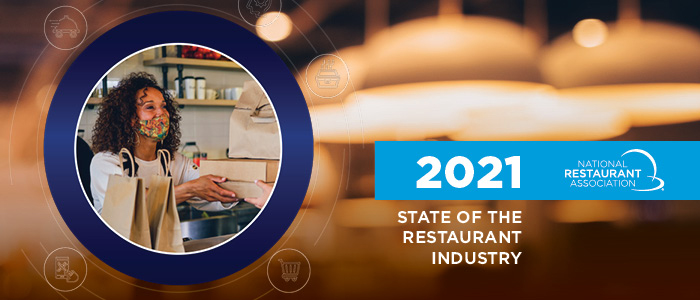The National Restaurant Association released its 2021 State of the Restaurant Industry Report, which measures the impact of the coronavirus pandemic on the restaurant industry and examines the current state of key pillars including technology and off-premises, labor, and menu trends across segments based on a survey of 6,000 restaurant operators and consumer preferences from a survey of 1,000 adults. The report also provides a look at the path to recovery for chains, franchises, and independents and the year of transition ahead.

Key findings regarding the impact of coronavirus on the restaurant industry include:
- Restaurant and foodservice industry sales fell by $240 billion in 2020 from an expected level of $899 billion.
- As of December 1, 2020, more than 110,000 eating and drinking places were closed for business temporarily, or for good.
- The eating and drinking place sector finished 2020 nearly 2.5 million jobs below its pre-coronavirus level.
“As we approach the one-year mark of pandemic-related dining restrictions, we know that virtually every restaurant in every community has been impacted. Amid an ever-changing landscape of dining restrictions and widespread closures, restaurants found ways to adapt, keep people employed, and safely serve our guests,” said Tom Bené, President & CEO of the National Restaurant Association. “While we still have a long way to go, we are confident in the resilience of the industry’s workforce, operators, suppliers, and diners. The year ahead will be critical as we continue to advocate for much-needed recovery funds to help get our industry back on track. Working together as one, I am confident in our ability to continue safely serving our guests and supporting our communities.”
Accelerated Development and Adoption of Technology and Off-Premises
State and local mandates forced operators to make developments to streamline or enhance off-premises and contactless capabilities, and many restaurants across all segments have become more efficient as a result. The pandemic induced a widespread adoption of technology and off-premises use among groups that may not have otherwise engaged in off-premises. Takeout and delivery have become a part of people’s routines with 68% of consumers more likely to purchase takeout from a restaurant than before the pandemic and 53% of consumers that say takeout and delivery is essential to the way they live.
Other key takeaways include:
- 64% of delivery customers prefer to order directly from the restaurant and 18% prefer to order through a third-party service.
- 72% of adults say it’s important their delivery orders come from a location that they can visit in person—as opposed to a virtual kitchen space.
Legacy Businesses Lost
Of restaurants that closed for good in 2020, the majority were well-established businesses and fixtures in their communities. These operators had been in business, on average, for 16 years, and 16% of them had been open for at least 30 years. Additional data on these businesses include:
- They employed an average of 32 people; 17% employed at least 50 people before they closed.
- 72% of restaurant owners who closed for good say it’s unlikely they’ll open another restaurant concept in the months or years ahead.
- Only 48% think they’ll stay in the restaurant industry in some form in the months or years ahead.
Devastating Year for the Restaurant Workforce
The restaurant and foodservice industry were projected to provide 15.6 million jobs in 2020 representing 10% of all payroll jobs in the economy. The impact of the pandemic has caused staffing levels to fall across all restaurant and foodservice segments with restaurant employment below pre-pandemic levels in 47 states and D.C. Key figures on the restaurant workforce include:
- 62% of fine dining operators and 54% of both family dining and casual dining operators say staffing levels are more than 20% below normal.
- There are nearly two million fewer 16-to-34-year-olds in the labor force, the most prominent age cohort in the restaurant industry workforce.
- Restaurants were hit harder than any other industry during the pandemic, and still have the longest climb back to pre-coronavirus employment levels.
Streamlined Menus with Comfort Food and Alcohol To Go
While restaurants continue to optimize and streamline operations, their menus prove no exception with 63% of fine dining operators and half of casual and family dining operators saying they have fewer items on the menu than before the pandemic. Consumers are equally influenced to choose one restaurant over another if the restaurant offers a good selection of comfort foods and/or dishes on the healthier side, but the availability of diet-specific fare such as vegan or gluten-free plays a lesser role in restaurant-choice criteria. The availability of alcohol to go with takeout orders, however, is an influence in restaurant choice.
Restaurants are meeting these demands with 1 in 5 family and casual dining operators adding comfort items and 7 in 10 full-service operators adding alcohol to go since March 2020. Consumers are also finding new ways to enjoy their favorite restaurants such as embracing bundled meals, restaurant subscription services, and meal kits. Key data points on food and beverage trends include:
- 38% of on-premises and 33% of off-premises customers say their restaurant choices will be influenced by whether the menus include the comfort foods they crave.
- 38% of on-premises customers say healthy choices would impact their restaurant choice.
- 35% of off-premises customers—with millennials leading the category at 53%—are more likely to choose a restaurant if it offers the option of including alcoholic beverages with the to-go order.
Pent-Up Consumer Demand Remains High
There is no doubt consumers are ready to return to restaurants. Restaurants are an integral part of our social fabric, and 6 in 10 adults say restaurants are an essential part of their lifestyle. In late April 2020, 83% of adults said they were not eating on-premises at restaurants as often as they’d like, a big jump from the 45% reported in January 2020. Baby boomers really want to return to restaurants, beating out Gen Z adults and millennials who say they are not eating on-premises at restaurants as often as they’d like. Additional data that validate pent-up demand include:
- 88% of adults enjoy going to restaurants and 85% of them say going out to a restaurant with family or friends is a better way to spend their leisure time than cooking (and cleaning) at home.
- Nearly 8 in 10 adults say their favorite restaurant foods deliver flavor and taste sensations that just can’t be duplicated in the home kitchen.
- A majority of adults across all generations say they are not eating at restaurants as often as they would like.
“Restaurants are the cornerstone of our communities, and our research shows a clear consumer desire to enjoy restaurants on-premises more than they have been able to during the pandemic. We’ve also found that even as the vaccine becomes more available and more social occasions return to restaurants, consumers will continue to desire expanded off-premises options going forward. Both will continue to be key for industry growth,” said Hudson Riehle, Senior Vice President, Research and Knowledge Group, National Restaurant Association. “With more than half of adults saying that restaurants are an essential part of their lifestyle, we are confident that, with time, the industry is positioned for successful recovery.”








